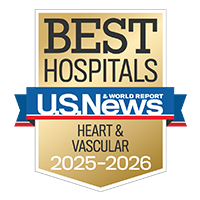Carotid Artery Disease

Overview
What is carotid artery disease?
The carotid arteries – the large blood vessels found on both sides of your neck – supply the brain with blood. When fatty deposits called plaque build up in the carotid arteries, the blood vessels become narrow and hardened. This condition, called carotid artery disease or carotid artery stenosis, can lead to a stroke.
Our approach to carotid artery disease
UCSF offers compassionate, cutting-edge care for people with carotid artery disease. For mild cases, treatment may include lifestyle changes, medications and careful monitoring of the narrowed artery. If the condition progresses, we offer carotid endarterectomy surgery as well as a less invasive option (balloon angioplasty and stenting) to remove the blockage and restore blood flow. UCSF's vascular surgery program has many decades of experience in performing carotid artery surgery to prevent strokes.
Awards & recognition
-

Among the top hospitals in the nation
-

One of the nation's best for heart & vascular care
Causes of carotid artery disease
Carotid artery blockages are caused by atherosclerosis, when an accumulation of plaque deposits causes narrowing and hardening of the arteries. Risk factors for atherosclerosis include:
- Diabetes
- High blood pressure
- High cholesterol
- Cigarette smoking
In addition to atherosclerosis, there are less-common conditions that can affect the carotid arteries, including:
- Aneurysms. An abnormal bulge or ballooning of an artery is caused by a weakening of the artery wall.
- Carotid artery dissection. A tear in the inner layers of the artery wall. This allows blood to get between the layers and separate them.
- Carotid body tumors. These tumors develop in cells surrounding the carotid arteries.
- Fibromuscular dysplasia (FMD). Abnormal cell growth in the artery walls causes the vessels to narrow, tear or bulge.
- Innominate artery disease. This is a rare condition caused by blockages in an artery below the carotid artery that supplies blood to the head, neck and arms.
- Recurrent blockages. Blockages can happen again after a person has had carotid artery surgery.
Symptoms of carotid artery disease
In its early stages, carotid artery disease may not have any symptoms. However, your doctor may be able to hear a whooshing sound when listening to your artery with a stethoscope.
The first sign may be a stroke, or a stroke-like event called a transient ischemic attack (TIA) that causes temporary symptoms. Symptoms of both stroke and a TIA include:
- Weakness or paralysis of a limb or one side of the body
- Inability to speak or articulate clearly
- Blindness or other visual changes in one or both eyes
- Loss of coordination or balance problems
- Numbness or dizziness
If you are experiencing any of the above symptoms, please call 911.
Diagnosis of carotid artery disease
Carotid artery blockages can be diagnosed easily with ultrasound imaging, a painless and safe procedure that is performed on an outpatient basis.
If a more detailed image is needed to determine if you need surgery, your doctor may order other tests, such as:
Treatment of carotid artery disease
Treatments for carotid artery disease can vary, depending on the severity of the symptoms. Treatments for moderate disease may include:
- Lifestyle changes, including increasing your activity, eating heart-healthy foods, and quitting smoking
- Over-the-counter and prescription antiplatelet medicines to reduce the risk of blood clots, such as aspirin, clopidogrel and ticagrelor
If you have a severe blockage, you may need treatment to remove it. The options include carotid endarterectomy and balloon angioplasty and stenting.
Carotid endarterectomy for carotid artery disease
The most common treatment for severe carotid artery disease is a surgical procedure called a carotid endarterectomy .Several large studies in the 1990s demonstrated that the procedure was the best treatment for reducing the risk of stroke in patients with completely or partially blocked carotid arteries.
A carotid endarterectomy involves opening the artery, removing the plaque causing the narrowing, and then closing the artery, usually with a synthetic patch. During the procedure, a temporary bypass is often used to allow blood to flow around the area of surgery as it travels to the brain.
Not all patients are candidates for this surgery, particularly those who are in overall poor health or have other health issues that puts them at greater risk of having a stroke during the surgery.
Balloon angioplasty and stenting for carotid artery disease
Balloon angioplasty and stenting is a less invasive option for treating blockages in the carotid arteries. During this procedure, the surgeon makes a small incision in your groin and, guided by X-ray imaging, threads a catheter with a tiny, folded balloon on its tip through the blood vessels until it reaches the blockage in the carotid artery. The balloon in then inflated, which compresses the plaque against the walls of the artery. This widens the passageway, allowing more blood flow to the brain. The balloon is then deflated and removed.
A stent, a wire mesh tube, may be inserted along with the balloon and left in place to help keep the artery expanded.
Balloon angioplasty and stent procedures are recommended only for patients who aren't candidates for conventional surgery.
UCSF Health medical specialists have reviewed this information. It is for educational purposes only and is not intended to replace the advice of your doctor or other health care provider. We encourage you to discuss any questions or concerns you may have with your provider.





























